 Wheeeee! Nothing compares to a butt-naked bareback ride on the beach! Not sex! Not money! Not anything! 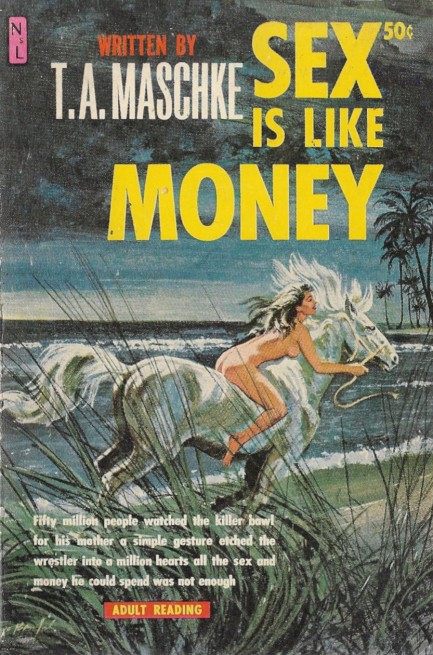
Robert Bonfils did well with this wild cover for T.A. Maschke's 1961 sleazer Sex Is Like Money. His art convinced us to give the book a shot (literaure buffs may notice, by the way, that this title predates John Updike's famous quip from his 1968 book Couples). Maschke tells the story of a Chicago cab driver and former pro wrestler named Mike Turner, who's asked by a mystery woman named Della to swim eight-hundred yards into Lake Michigan and back to retrieve a briefcase of dirty financial records she intends to toss off a yacht and give to tax authorities. Turner wants to get laid, so he goes along with the plan, manages to return to shore with the briefcase, but soon learns that it contains not documents but a million dollars. Oops—duped!
The money belongs to Chi-Town crime kingpin Killer Canasta, and obviously he'll be furious—the guy is known as Killer, after all—so Della plans to flee to South America. She's willing to take Turner along, but he drags his feet, arguing instead that they should give the money to the feds and collect a reward. Dumb, right? Turner then discovers Della has an identical twin sister named Ella and things get weird. The tale eventually ends with a televised wrestling match in Soldier Field between Turner and Canasta. How does Maschke manage to bend the narrative toward that bizarre conclusion? It doesn't matter, because under no circumstances should you read Sex Is Like Money. And you always take our advice, right? Trust us this time—it's terrible. And on we go to the next...
 Now I'd like to do a little number about the fantastic sex I'm going to have later with a random member of the audience. 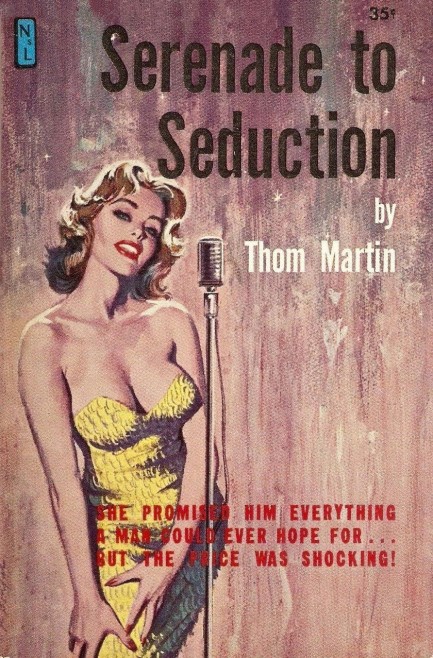
Above: a Robert Bonfils cover for Thom Martin's sleazer Serenade to Seduction, which came from Newsstand Library in 1960. We figure the singer here, after making her announcement, goes right into a steamy rendition of Dinah Washington's “Big Long Slidin’ Thing.”
 You wanna do something really wild? How about you and my husband swap bank accounts instead? 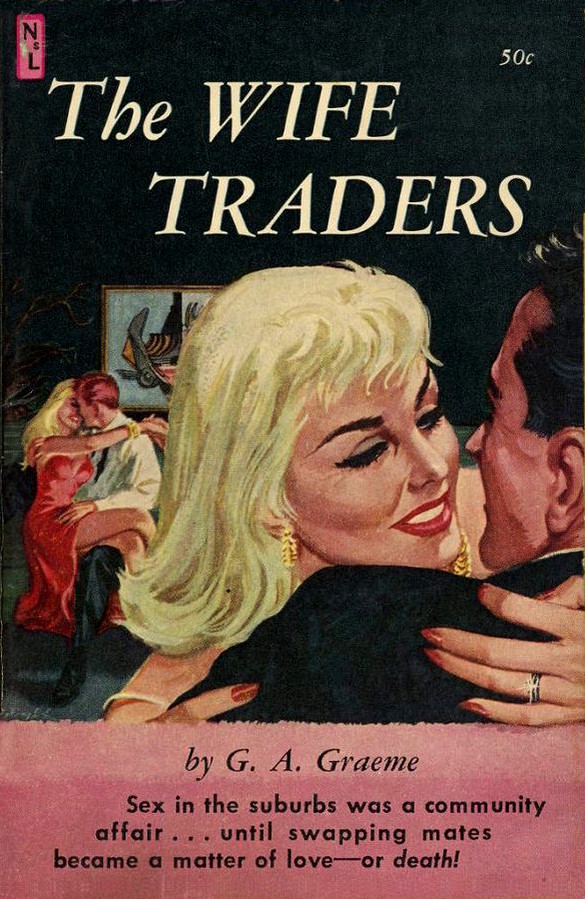
Robert Bonfils is on cover duty for G.A. Graeme's The Wife Traders, from Newsstand Library, circa 1959. Here a weekly bridge game turns into a swinging free-for-all, which of course leads to death. The story is written in the form of an investigation of two murders by an intrepid reporter who has to go undercover to crack the case wide open. Nothing new, but we always dig Bonfils.
 I always get confused about this. So, like, if you're my mother's husband does that mean you can or can't spank me? 
Above, a cover for My Mother's Husband, written by M. Anderson for Newsstand Library, a company based in Chicago. M. Anderson is obviously a pseudonym whose real identity seems lost to time, and believe it or not, this is actually a detective story. It's copyright 1960, with Robert Bonfils art.
 You excite me so much, darling, but that's not my heart making that noise. That's my gastrointestinal tract. 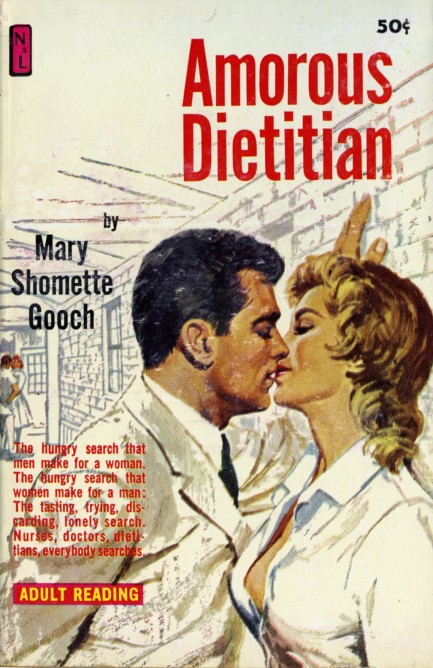
Above, a cover for the medical romance novel Amorous Dietician by Mary Shomette Gooch, 1961, with art by Robert Bonfils. Gooch, who has such a ridiculous name you have to suspect it's real, also wrote Cheating Woman, The Tainted Rosary, and The Lusting Breed as Mary S. Gooch. And if you say that fast, you can make it sound like “Mary's gooch,” which would be funny but it turns out women don't have have gooches. Only men do—we looked it up.
 Yes, dear, I replaced my flirtatious young assistant with a white-haired older lady, just like you wanted me to. 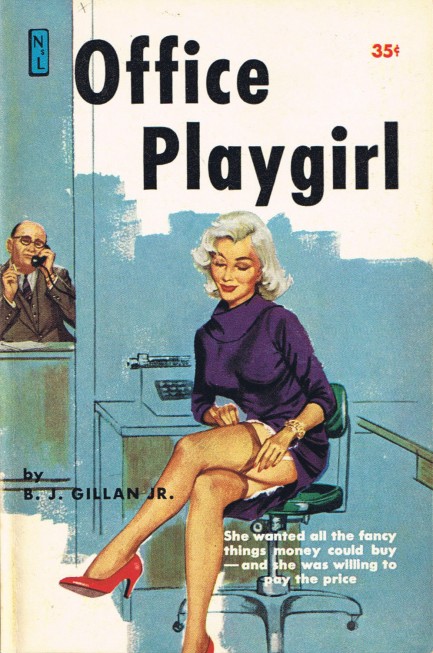 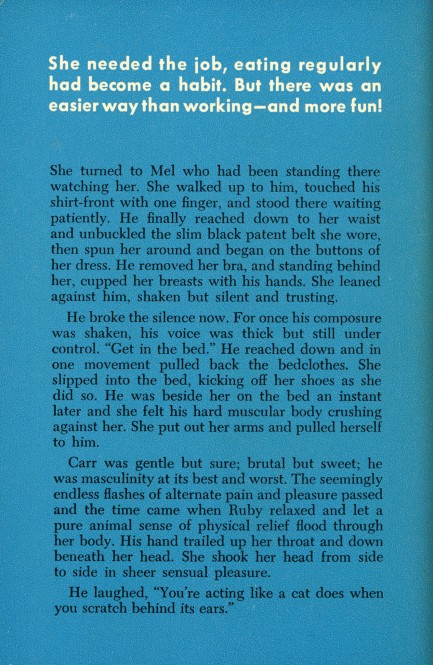
Above, another entry in the office sleaze genre—B. J. Gillan Jr.'s Office Playgirl, from Newsstand Library, 1960. We've included the rear cover so you can get the gist of it yourself. The art is uncredited,
 Actually, she isn't the youngest anymore. But she's been a harlot for some years and it's sort of an honorary title now. 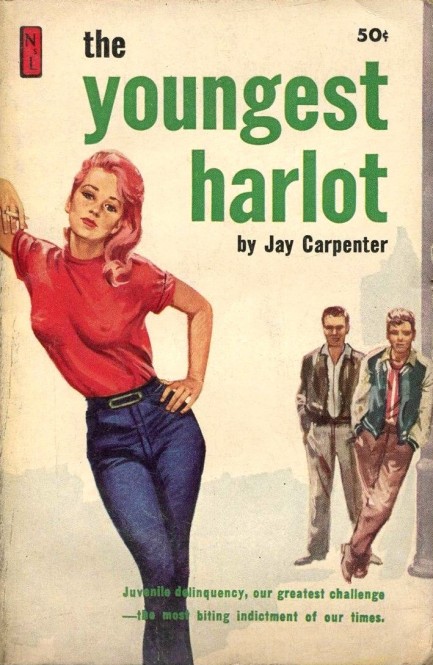
Above, an amusing cover for The Youngest Harlot by Jay Carpenter, from Newsstand Library, 1961. The cover text, in case you can't read it, says juvenile delinquency is the most biting indictment of our times. The fiction bites a little bit too, but in a fun way. If you're inclined you can find out for yourself by downloading a copy at TripleX Books. The art, by the way, could fit into our collection of characters leaning against poles, which makes the cover a winner for us. Thank Robert Bonfils.
 Good sleaze can be like beautiful music. 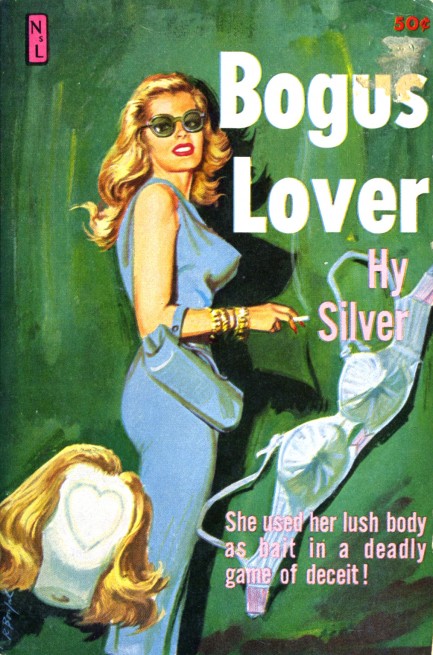
Above you see a really nice Robert Bonfils cover for Bogus Lover, published by Newsstand Library in 1960. What's bogus, though, is how the author got ambushed on this one. According to mysteryfile.com, Hy Silver—his real name, by the way—originally wrote a standard detective thriller that was converted without consent into a sleaze novel. And what a conversion: “Her hips began to sway in low, rhythmic circles, eager with anticipation, then faster until they were undulating to a restless mambo beat.” Note to aspiring novelists—remember to use Latin American music as a metaphor for really good sex. The rumba works, as do the samba and bolero, and the tango is a really good one, especially when describing the interaction of two tongues. We're giving you this for free. Run with it.
 Wow! He's really mastered some hot licks! 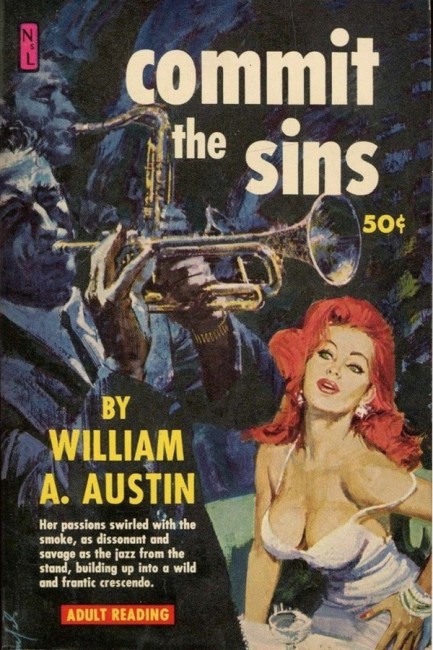
There's something special about how a great talent handles his instrument, right? It becomes an extension of him. A real virtuoso uses every technique in his repertoire—double and triple tonguing, lip trills, circular breathing, and of course quick valve water emptying—until it all comes together in one climactic crescendo. By the way, if you don't know what quick valve water emptying is, well child, you better ask somebody. In the past most players were men, but of late there are plenty of women who blow masterfully. The best often do dates in the legendary Trumpet City. That place is tops... Um, yeah. 1961 on this, with Robert Bonfils art.
 She’s finally going to make her mark on Broadway. 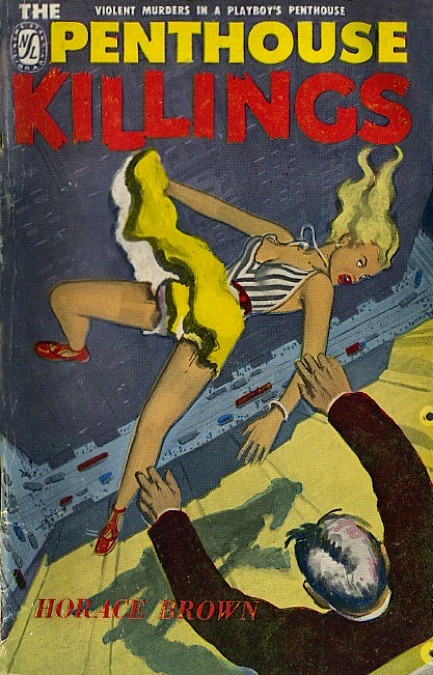
The comic book-like art isn’t of good quality, but we had to share this because it fits into the collection of falling covers we put together a while back. The Penthouse Killings was written by Horace Brown for Toronto based Newsstand Library in 1950. If you actually want to know why this ballerina is tossed off a building, check the detailed review here.

|
 |

The headlines that mattered yesteryear.
2003—Hope Dies
Film legend Bob Hope dies of pneumonia two months after celebrating his 100th birthday. 1945—Churchill Given the Sack
In spite of admiring Winston Churchill as a great wartime leader, Britons elect
Clement Attlee the nation's new prime minister in a sweeping victory for the Labour Party over the Conservatives. 1952—Evita Peron Dies
Eva Duarte de Peron, aka Evita, wife of the president of the Argentine Republic, dies from cancer at age 33. Evita had brought the working classes into a position of political power never witnessed before, but was hated by the nation's powerful military class. She is lain to rest in Milan, Italy in a secret grave under a nun's name, but is eventually returned to Argentina for reburial beside her husband in 1974. 1943—Mussolini Calls It Quits
Italian dictator Benito Mussolini steps down as head of the armed forces and the government. It soon becomes clear that Il Duce did not relinquish power voluntarily, but was forced to resign after former Fascist colleagues turned against him. He is later installed by Germany as leader of the Italian Social Republic in the north of the country, but is killed by partisans in 1945.
|

|
|

It's easy. We have an uploader that makes it a snap. Use it to submit your art, text, header, and subhead. Your post can be funny, serious, or anything in between, as long as it's vintage pulp. You'll get a byline and experience the fleeting pride of free authorship. We'll edit your post for typos, but the rest is up to you. Click here to give us your best shot.

|
|


























































































